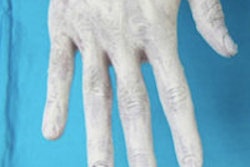In a retrospective study, overlooked lung nodules were found in 41 patients on 41 chest radiographs. A subtlety rating from 1 to 10 (1 being very subtle) was assigned to each radiograph. All 41 images were analyzed by a next-generation CAD algorithm for lung cancer detection (OnGuard 5.2, Riverain Medical).
Subtlety ratings ranged from 1 to 9 (mean, 2.39; mode, 2). Overlooked lesions were distributed in the upper lobes, with 41.4% in the right upper lobe and 19.5% in the left upper lobe.
The CAD algorithm detected 28 of the 41 lesions (sensitivity, 67%). The CAD-detected lesions were in the right upper lobe and apex (13, 31.7%) and left upper lobe and apex (8, 19.5%). The most common pathologic diagnoses were adenocarcinoma, squamous cell carcinoma, and metastatic lesions. There was a false-positive average of 0.75 per image; the majority of false-positive marks were located in the upper lobes, often overlying bony structures and pleural surfaces.
"There are a large number of lung cancer patients who have never smoked," said Dr. Robert Gilkeson from University Hospitals in Cleveland. "As a chest radiologist, we know that we all can 'miss' these unsuspected cancers on chest x-rays, and that the 'missed' lung cancer can be a common cause of malpractice lawsuits."
In the future, he would like to assess the CAD algorithm in CT lung cancer screening programs. A prospective trial would be particularly helpful, he added.



















